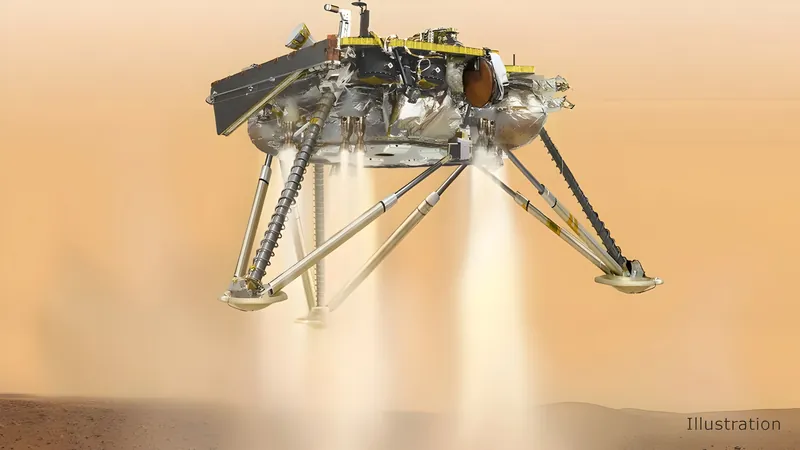
NASA's InSight Lander: Unveiling the Secrets of Mars Even After Retirement
2024-12-29
Author: Sophie
The End of an Era, But Not the End of Knowledge
After landing on Mars in November 2018, InSight made history as the first spacecraft to detect and analyze marsquakes, offering significant revelations about the planet's geological structure. However, despite its groundbreaking mission, the lander faced challenges when its solar panels became covered in Martian dust, leading to a decline in power. NASA made several attempts to re-establish communication, hoping wind would clear the dust, but as those efforts failed, the team ultimately decided to end its investigations in late 2022.
Learning from the Past: Mars' Dust Dynamics
Though it may no longer be operational, InSight's data continues to be harnessed by NASA’s Mars Reconnaissance Orbiter (MRO). Scientists, using high-resolution images from MRO's HiRISE camera, are studying how dust settles on InSight’s solar panels. This research reveals important information about the Martian dust cycle – an essential element influencing both the planet's climate and surface processes.
Ingrid Daubar from Brown University acknowledged this ongoing influence, stating, 'Even though we’re no longer hearing from InSight, it’s still teaching us about Mars. By observing dust accumulation and removal, we gain insights into the wind patterns and other dynamic processes shaping the Martian environment.'
The Martian Wind: Dust Devils and Atmospheric Insights
Dust is not merely an aesthetic layer; it drives the very forces that sculpt the Martian landscape and atmosphere. During InSight's active months, scientists monitored the movement of dust devils across the surface, revealing a seasonal pattern where dust activity surged in the summer and waned in winter. This information is critical in understanding Martian weather systems.
Interestingly, studying how dust collects over impact craters allows researchers to estimate the age of these formations. Unlike Earth, where landscapes constantly evolve due to tectonic activity, Martian craters provide a glimpse back in time, harboring stories of a planet largely unchanged for millions of years.
A Legacy of Collaboration
InSight was a result of extensive collaboration across the globe, involving contributions from various international partners like France's CNES and Germany’s DLR. Managed by NASA's Jet Propulsion Laboratory, the mission was part of the Discovery Program, which aims to investigate celestial bodies in innovative ways.
Although it may now be silent, the legacy of InSight lives on, enriching our understanding of Mars through its findings on atmospheric phenomena and geological processes.
Seasons of Mars: Insights for Future Explorations
One of the greatest contributions of InSight’s mission was the comprehensive data it provided concerning Martian seasonal patterns. By analyzing these findings together with the MRO’s data, scientists have learned how the planet's axial tilt and orbital changes affect dust activities.
During summer, the resultant rise in temperatures spurs stronger winds and more frequent dust devils, important phenomena to consider for future missions. This understanding is crucial for ensuring the safety and effectiveness of solar-powered systems that will be sent to Mars.
InSight’s pioneering recordings of atmospheric conditions, combined with MRO imaging, have also enabled researchers to track the lifecycle of Martian dust storms – insights that will be invaluable for protecting human explorers in the future.
Conclusion
Despite the official end of its mission, the InSight lander continues to be a beacon of knowledge about Mars. With its rich data, scientists are piecing together the intricate puzzle of Martian geology and climate, ensuring that the legacy of this extraordinary mission will endure. The footprints left by InSight provide an enduring foundation for our understanding of the Red Planet, guiding both current and future exploration endeavors.
Stay Updated!
For those captivated by space exploration, stay tuned for more exciting updates and discoveries as we continue to unravel the mysteries of the universe!



 Brasil (PT)
Brasil (PT)
 Canada (EN)
Canada (EN)
 Chile (ES)
Chile (ES)
 Česko (CS)
Česko (CS)
 대한민국 (KO)
대한민국 (KO)
 España (ES)
España (ES)
 France (FR)
France (FR)
 Hong Kong (EN)
Hong Kong (EN)
 Italia (IT)
Italia (IT)
 日本 (JA)
日本 (JA)
 Magyarország (HU)
Magyarország (HU)
 Norge (NO)
Norge (NO)
 Polska (PL)
Polska (PL)
 Schweiz (DE)
Schweiz (DE)
 Singapore (EN)
Singapore (EN)
 Sverige (SV)
Sverige (SV)
 Suomi (FI)
Suomi (FI)
 Türkiye (TR)
Türkiye (TR)
 الإمارات العربية المتحدة (AR)
الإمارات العربية المتحدة (AR)